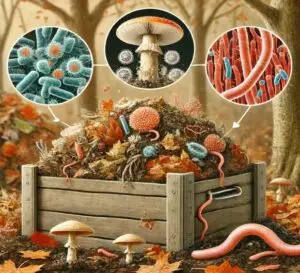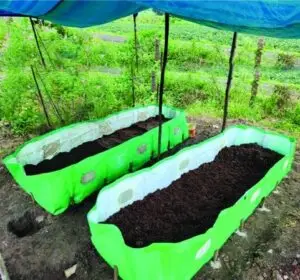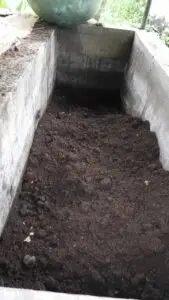Vermicomposting
Introduction
Vermicomposting transforms organic waste into nutrient-rich compost by using earthworms and microorganisms. Vermicast, often referred to as worm castings, is a kind of compost that acts as a natural fertilizer and soil conditioner. Vermicomposting, an environmentally beneficial technique, recycles food scraps, agricultural waste, and plant debris, turning organic matter into a useful product that improves soil health and encourages plant development.

Characteristics of Vermicomposting
- Biological Mechanism: Earthworms and microorganisms contribute to the biological breakdown of organic materials.
- Odorless: With appropriate management, it emits very little to no offensive odors.
- Optimal temperature range: Between 15 and 30 degrees Celsius (mesophilic).
- Moisture Dependent: The optimum range for moisture content is 60–80%.
- Aerobic Process: Needs good ventilation for the health and breakdown of worms.
- High Nutrient Content: The finished product is packed with enzymes, beneficial microbes, nitrogen, phosphorus, and potassium.
Organisms involved & their roles
- Earthworms (Primary decomposers): Perionyx excavatus, Eisenia fetida, Eudrilus eugeniae, and other species were employed. Function: To break down and consume organic matter, combine it with soil microorganisms, and expel nutrient-rich castings.
- Bacteria: To convert complicated organic molecules into simpler ones; to provide nutrients for plants.
- Fungi Function: Helps in the breakdown of difficult plant waste by breaking down lignin and cellulose-rich substances.
- Actinomycetes Role: Assist in the creation of humus by breaking down tenacious chemicals like cellulose.
- Mites and Protozoa Responsibilities: Assist with secondary breakdown and keep a healthy microbial balance.

Types of Vermicomposting
Different Kinds of Vermicomposting The various forms of vermicomposting are determined by the quantity of production and the composting facilities.
- Small-Scale Vermicomposting: When vermicomposting is done on a small scale to meet individual demands, a farmer may collect 5 to 10 tonnes of vermicompost annually.
- Large-scale Vermicomposting: This method generates 50 to 100 tons of organic trash annually on a business basis.
Methods of Vermicomposting
Vermicomposting Techniques Although there are several methods for producing vermicompost, the Bed and Pit methods are the most well-liked.
- Bed Method: The bed approach involves composting on the pucca or kachcha floor by creating a 6x2x2 foot bed of organic material. Using this strategy is easy, and upkeep is minimal.
- Pit Method: The pit method is the composting of material in cement pits that are 5×5×3 feet in size. The structure is covered with native materials like thatch grass. This approach is not preferred because it is more expensive to manufacture, generates more waste, and has low aeration.
Process of Vermicomposting
1. Site selection
Choose a cold, shaded, and damp place for the compost pit, ideally under trees or a simple shed to protect it from direct sunlight and rain. To avoid water logging, a well-drained location is required since earthworms thrive in steady, humid conditions.
2. Bed preparation
Lay a 15–20 cm thick layer of wet bedding using materials such as partially decomposed cow manure, shredded paper, dry leaves, or coconut coir. The bedding should be soft and breathable, providing a good habitat for worms and beneficial microorganisms.
3. Earthworms
Introduce around 1000 earthworms per square meter of bedding. Species such as Eisenia fetida are excellent due to their rapid composting capabilities. Add them during the cooler portions of the day to help them relax and adjust more rapidly.
4. Add organic waste
Over the mattress, apply thin layers of kitchen trash, vegetable peel, and crop residue. Avoid meat, dairy, and greasy or acidic leftovers since they might be toxic to the worms. Cover each layer with cow manure or dried leaves to minimize odour and fly issues.
5. Moisture and Aeration
Maintain the compost moist like a wrung-out sponge (60-80 percent moisture). To promote appropriate ventilation, spray water as needed and gently stir the compost every few days. Good ventilation prevents unpleasant odors and aids in faster decomposition.
6. Harvesting
The compost turns dark, crumbly, and earthy-smelling after 45–60 days. To allow worms to migrate down, stop feeding for a few days before harvesting the top layer. Store the compost in a cold, dry location and reuse the worms for the next batch.
Factors affecting vermicomposting
Feeding
Improves earthworm development, reproduction, and cocoon output. Moisture, particle size, substrate organic content, and feed pre-treatment all have an impact on the feeding rate. High organic matter decreases worm activity, boosting anaerobic microbial activity, resulting in anaerobic and foul odor environments. Toxic metals, when present in the organic food, kill worms.
pH
Neutral pH is ideal for worm function, although the favorable range has been reported to be 4. 5–9. 0.It primarily depends on earthworm sensitivity and the physicochemical features of the garbage. The fluctuation in waste physicochemical features mostly affects the pH of vermicomposting. Some intermediates generated during vermicomposting, such as ammonium and humic acids, affect pH changes.
Temperature
The ideal temperature range for earthworm activity, growth, metabolism, respiration, reproduction, and cocoon creation is 25–37°C, which also promotes the growth of earthworm-related microorganisms. The reaction to temperature varies depending on the earthworm species. Eisenia fetida, for example, thrives at 25°C and has a temperature response range of 0–35°C. For example, Eisenia fetida thrives at 25 °C with a temperature tolerance of 0-35 °C, whereas Dendrobaena Veneta grows best at lower temperatures and has limited tolerance for extreme temperatures.
Moisture
Researchers have linked earthworm growth to the humidity content of the vermicomposting system. They recommend an ideal moisture content ranging from 50 to 80% for effective vermicomposting; nevertheless, they have also found that a moisture content of up to 90% is effective for vermicomposting. Low moisture conditions delay earthworms’ sexual development. Eisenia fetida has been found to have an ideal moisture level of 70-80%.
Advantages & Disadvantage of Vermicomposting
Advantages
- Soil Enrichment: Vermicompost is a nutrient-rich organic fertilizer that enhances soil fertility, water retention, and physical structure. Vermicompost contains necessary nutrients like nitrogen, phosphorus, potassium, and calcium, which contribute to increased plant development, crop production, and soil quality.
- Soil Aeration: Vermicomposting promotes soil aeration and drainage by changing soil structure. As a result, plants develop deep and strong roots.
- Plant Growth: Vermicompost includes plant growth hormones such as auxins, gibberellic acid, and cytokinins that aid in the germination, growth, and development of plants.
- Water-Resistant Soil: Vermicompost can absorb water and store it for extended periods of time. This improves the soil’s water resistance, reducing the need for frequent watering.
- Environmentally Sustainable: Vermicomposting is an ecologically beneficial technique that reduces the amount of waste sent to landfills. It also eliminates the requirement for synthetic fertilizers, which can have detrimental environmental effects.
Disadvantage
- Time-consuming Process: Vermicomposting is a slow process that takes several weeks or months for the organic matter to completely convert into vermicompost. This may make it less practical for people who need a quicker turnaround.
- Foul Odor: A strong, unpleasant odor can arise from the breakdown process, especially if someone does not manage the composting pile properly. This may be an issue for individuals who live near to the composting facility.
- High Maintenance: Vermicomposting needs frequent monitoring and maintenance to guarantee that the earthworms and composting process are in ideal circumstances. This includes monitoring moisture content, temperature, and pH.
- Pest and Pathogen Growth: The composting process may also attract pests and pathogens, including fruit flies, centipedes, and flies. This may be a concern for people who want to keep these species away from their compost.
Role of vermicomposting in agriculture
Vermicomposting is an important component in sustainable agriculture because it uses earthworms to transform organic material into nutrient-rich compost. This natural process improves soil fertility by increasing the availability of essential nutrients such as nitrogen, phosphorus, and potassium, as well as improving soil structure, aeration, and water retention.
Vermicompost includes useful bacteria and plant growth hormones that improve good crop development and reduce soil borne illnesses. It provides an ecologically friendly option to chemical fertilizers, minimizes agricultural waste, and promotes organic farming methods, which improves soil health, boosts crop yields, and reduces environmental effect.
Reference and Sources
Also Read:
- Probiotics: Benefits for Your Gut Health
- Overview of bioreactor or fermenters
- Introduction of Plant-Microbe Association and the Mycorrhizae
- Bioremediation: Definition, Types, Process and Application
- Phosphate & potassium solubilizing bacteria as PGPR
- Influence of Environmental Factors on Microbial Growth



